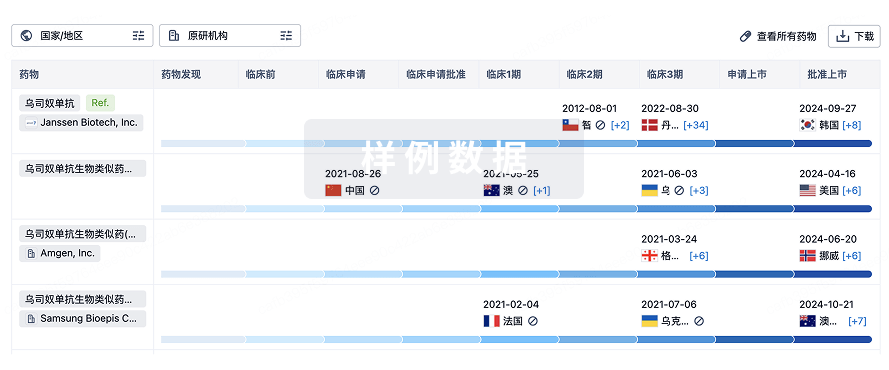预约演示
更新于:2025-12-20
LM-108
更新于:2025-12-20
概要
基本信息
原研机构 |
在研机构 |
非在研机构- |
最高研发阶段临床3期 |
首次获批日期- |
最高研发阶段(中国)临床3期 |
特殊审评孤儿药 (美国)、突破性疗法 (中国) |
登录后查看时间轴
结构/序列
Sequence Code 21491CDR2-L

Sequence Code 150180CDR1-H

Sequence Code 150916CDR3-L

Sequence Code 524306259CDR1-L

Sequence Code 524754937CDR2-H

Sequence Code 1047127012CDR3-H

Sequence Code 1047127015VH

Sequence Code 1047127017VL

关联
14
项与 LM-108 相关的临床试验NCT06825494
An Open-label Phase Ib/II Clinical Study to Evaluate the Safety, Tolerability, and Preliminary Efficacy of LM-108 ± Penpulimab + Chemotherapy in Patients With Advanced Solid Tumors - Cohort A
This trial is part of a multicenter, open-label Phase Ib/II clinical study evaluating the efficacy, safety, and tolerability of LM-108 in combination with anti-tumor therapy in patients with advanced solid tumors. Phase Ib of Cohort A1 determines the dose of LM-108 in combination with penpulimab + oxaliplatin + capecitabine. Phase II explores the efficacy and safety of LM-108 in combination with anti-tumor therapy in patients with advanced solid tumors.
开始日期2025-04-08 |
申办/合作机构 |
CTR20250649
评估 LM-108±派安普利单抗+化疗在晚期实体瘤患者中的安全性、耐受性以及初步疗效的开放标签 Ib/II 期临床研究-队列 A 组
评估 LM-108 联合抗肿瘤治疗在晚期实体瘤患者中的有效性、安全性和耐受性
开始日期2025-04-02 |
申办/合作机构 |
CTR20250632
评估LM-108±派安普利单抗+化疗在晚期实体瘤患者中的安全性、耐受性以及初步疗效的开放标签Ib/II期临床研究-队列C组
Ib期评估LM-108联合抗肿瘤治疗在晚期胰腺癌的剂量限制毒性事件和II期研究中的推荐剂量。
II期评估LM-108联合抗肿瘤治疗在晚期胰腺癌患者中的有效性和安全性。
开始日期2025-03-27 |
申办/合作机构 |
100 项与 LM-108 相关的临床结果
登录后查看更多信息
100 项与 LM-108 相关的转化医学
登录后查看更多信息
100 项与 LM-108 相关的专利(医药)
登录后查看更多信息
1
项与 LM-108 相关的文献(医药)2025-08-01·Journal of Thoracic Oncology
Selective Depletion of CCR8+Treg Cells Enhances the Antitumor Immunity of Cytotoxic T Cells in Lung Cancer by Dendritic Cells
Article
作者: Zhou, Caicun ; Li, Xuefei ; Chen, Peixin ; Zhao, Chao ; Shi, Jinpeng ; Tang, Zhuoran ; Cheng, Lei ; Wang, Haowei
INTRODUCTION:
Accumulation of regulatory T (Treg) cells, an immunosuppressive population, limits the efficacy of immunotherapy in NSCLC. C-C motif chemokine receptor 8 (CCR8) is selectively expressed in tumor-infiltrating Treg cells and is, therefore, considered an ideal target.
METHODS:
The efficacy and safety of anti-CCR8 monotherapy and its combination with programmed cell death protein-1 (PD1) inhibitor were evaluated in four NSCLC-bearing mice models. To track the dynamic changes in tumor microenvironment, we performed the single-cell RNA sequencing, the single-cell T-cell receptor sequencing analysis, the flow cytometry, the multi-color immunofluorescence, and the Luminex assay on tumors after three, seven, 14, and 21 days of different treatment regimens. Then, in vitro and in vivo experiments were applied to validate our findings and explore molecular mechanisms of the synergistic effects.
RESULTS:
Across four NSCLC-bearing mice models, the combination of CCR8 antibody and PD1 inhibitor significantly reduced tumor growth (p < 0.05) without obvious mouse body weight drops and systemic cytokine storm. The anti-CCR8 therapy synergizes with PD1 blockade by remodeling the tumor microenvironment and disrupting CCR8+Treg-C-C motif chemokine ligand 5 (CCL5)+ dendritic cells (DC) interaction. Mechanistically, therapeutic depletion of CCR8+Treg cells combined with PD1 inhibitor extremely increased interleukin-12 secretion by the Janus kinase-signal transducer and activator of transcription (JAK-STAT) pathway activation on CCL5+ DCs, thereby promoting cytotoxic activity of CD8+ T cells. The therapeutic potential of the CCR8 antibody LM-108 in combination with immunotherapy was observed in clinical patients with advanced NSCLC.
CONCLUSION:
Overall, CCR8 expression on tumor-infiltrating Treg cells is correlated with immunosuppressive function on DCs and CD8+ T cells, thus impeding antitumor immunity.
79
项与 LM-108 相关的新闻(医药)2025-12-16
·有驾
CCR8(CC基序趋化因子受体8),是一种在调节性T细胞(Treg)上特异性高表达的趋化因子受体。它属于G蛋白偶联受体,与四种已知配体CCL1、CCL8、CCL16和CCL18相结合。多项研究显示,CCR8的高表达与多种肿瘤如结直肠癌、乳腺癌、胃癌等密切相关,因此被视为一个颇具潜力的肿瘤免疫靶点。
❒ CCR8的特性与相关癌症
在深入了解CCR8的作用机制之前,我们首先来了解一下趋化因子及其受体。趋化因子是一类由细胞分泌的小分子细胞因子或信号蛋白,它们在人体防御和清除入侵病原体等异物时发挥着关键作用。通过定向趋化免疫细胞,趋化因子在癌细胞的迁移、侵袭和转移过程中扮演着至关重要的角色。趋化因子受体则是一类表达在特定细胞表面的跨膜G蛋白偶联受体(GPCRs),它们与细胞外的配体结合后,会引发钙离子内流,进而诱导细胞向生物体的特定部位移动。
❒ 趋化因子与机制
CCR8作为唯一已知的CCL1受体,与T淋巴细胞、单核细胞以及肥大细胞分泌的小分子糖蛋白CCL1密切相关。当CCL1分泌到肿瘤微环境中后,它会激活癌细胞上的CCR8受体,从而引发癌细胞的增殖、迁移以及凋亡抵抗。此外,CCL1还能通过激活内皮细胞上的CCR8受体促进血管生成,进一步加速肿瘤的转移。更为重要的是,CCL1能够募集Treg到肿瘤生态位,并导致CD4+T细胞转化为Treg,进一步抑制抗肿瘤免疫反应。
随着CCR8被揭示为肿瘤免疫治疗中的关键靶点,针对该靶点的药物研发已成为新的研究焦点。尽管目前研究尚处于起步阶段,但全球多家制药企业已纷纷投身于这一领域。这些药物主要以单克隆抗体为主,同时也有部分小分子拮抗剂正在研发中,它们有望为肿瘤治疗带来新的突破。
❒ 针对CCR8的药物种类
在药物研发领域,针对CCR8的药物设计成为了新的研究热点。这些药物可以通过耗竭肿瘤浸润的FOXp3+CCR8+Treg细胞或阻断CCL1/CCR8途径来增强抗肿瘤免疫反应,为肿瘤治疗提供了新的策略和方向。BMS-986340作为全球首款进入临床试验的CCR8靶向单克隆抗体,其独特之处在于通过去岩藻糖基化技术,增强了抗体依赖的细胞介导的细胞毒性作用(ADCC)。
❒ JTX-1811与其他药物
JTX-1811,由Jounce Therapeutics公司开发,是一款针对CCR8的潜在FIC免疫疗法。其作用机理独特,能靶向肿瘤浸润性调节性T(TITR)细胞上富集的CCR8,通过增强ADCC机制选择性清除肿瘤微环境中的TITR细胞。S-531011,由Shionogi公司开发,是一种新型抗人IgG1抗体。L-873152,由礼新医药自主研发,能够通过ADCC效应特异性清除肿瘤中的Treg细胞。其他药物如LM-108等也在临床试验阶段,展示了抗肿瘤的潜力。
G蛋白偶联受体结构的多样性与模块化对其功能和药物靶向性具有重大意义。趋化因子在肿瘤微环境中的多样化作用及外泌体与CCR8+Treg细胞的相互作用,为研究提供了理论基础。这些深入的科学发现不断推动着对CCR8机制的理解,为未来的临床应用打下了坚实的理论基础和科学依据。
免疫疗法临床申请细胞疗法
2025-12-03
走进中国科学院大学附属肿瘤医院(浙江省肿瘤医院)I期临床试验病房
项 目
标题:评价SYN608在局部晚期或转移性实体瘤患者中的安全性、耐受性、药代动力学和初步抗肿瘤活性的首次人体I期研究
药物科普:SYN608是由杭州圣域生物医药科技有限公司(下文简称“圣域生物”)自主开发的一类新型口服小分子PARG抑制剂药物,拟用于治疗晚期实体瘤。SYN608对PARG酶和DNA损伤后PAR链的水解有较好的抑制作用,在体外多种肿瘤细胞和多个体内肿瘤模型中均展现出了显著的抗肿瘤效果。基于上述证据,SYN608作为一种治疗多种癌症的药物,具有广阔的临床前景。
适应症:局部晚期或转移性实体瘤
入选标准
1. 年龄:≥18岁(含边界值,以签署知情同意当日计算),性别不限;
2. 经组织病理学或细胞学证实,标准治疗失败、或无标准治疗方案、或现阶段不适合标准治疗的局部晚期或转移性实体瘤,包括BRCA1/2突变和/或其他HRR相关基因突变(包括ATM,BARD1,BRIP1,CDK12,CHEK1,CHEK2,FANCL,PALB2,PPP2R2A,RAD51B,RAD51C,RAD51D和RAD54L)的局部晚期或转移性实体瘤(包括卵巢癌/输卵管癌/原发性腹膜癌、子宫内膜癌、消化道肿瘤、前列腺癌和乳腺癌等),CCNE1扩增的实体瘤(包括卵巢癌/输卵管癌/原发性腹膜癌、子宫内膜癌、消化道肿瘤和乳腺癌等),以及小细胞肺癌等。所有患者入组前均需提供足够用于检测HRR相关基因突变和/或CCNE1扩增的生物样本。既往BRCA1/2和/或其他HRR相关基因突变的阳性报告和/或CCNE1扩增的NGS结果阳性的报告,经申办者和研究者评估合理后,可作为筛选依据。注:其中入组剂量组1和2(加速滴定组)的患者为经组织病理学或细胞学证实,标准治疗失败、或无标准治疗方案、或现阶段不适合标准治疗的局部晚期或转移性实体瘤,对基因突变不作要求;
3. 至少有一个可测量病灶(根据 RECIST v1.1标准)。
4. ECOG体力评分0或1分,有充足的骨髓及器官功能;
5. 自愿参加本试验并愿意签署知情同意书,并愿意配合治疗和随访。。
注:以上标准只是部分主要筛选标准,是否能够入组,以医生的判定为准。
项目联系人
许春伟 微信号:cwxu87
王文娴 微信号:dita0407SYN608 实体瘤项目由项目联系人负责与研究者对接
如您符合上述条件,请联系本研究的研究者,他将向您具体解释本研究的相关规定,并作充分的知情同意。在您自愿参加病签署了正式版本的知情同意书后,研究者将采取进一步的筛选检验/检查(这些检验/检查项目都是免费提供给您的),以确定您是否能够参加本研究项目。
经筛选检验/检查确认符合所有详细入组标准后,您将正式进入本次研究。研究中您将获得专业医师为您做疾病诊断、病情追踪观察和治疗指导,免费的实验药品和方案规定的检验/检查,以及部分交通补助费用和采血补偿费。
临床试验汇总
临床试验招募丨HA121-28片在晚期RET融合实体瘤患者中的最大耐受剂量探索及单、多次给药药代动力学研究I期临床试验临床试验招募丨阿美替尼一线治疗EGFR突变的肺腺鳞癌或腺癌和鳞癌混合成分癌的疗效和安全性研究:一项前瞻性、多中心、单臂临床研究临床试验招募丨SHR-4849注射液在晚期恶性实体瘤患者中的安全性、耐受性、药代动力学和有效性的多中心、开放的I期临床研究临床试验招募丨一项评估HC010治疗晚期实体瘤患者的安全性、药代动力学和抗肿瘤活性的多中心、开放、剂量递增和剂量扩展I期临床研究临床试验招募丨3HP-2827在FGFR2异常的手术不可切除/转移性实体瘤患者中的安全性、耐受性、药代动力学和疗效的开放、多中心1/2期临床研究临床试验招募丨HRS-4642联合抗肿瘤药物在晚期实体瘤受试者中的安全性、耐受性及有效性的IB/II期临床研究临床试验招募丨注射用SHR-7631在晚期实体瘤患者中的安全性、耐受性、药代动力学及疗效的开放、多中心I期临床研究临床试验招募一项在晚期实体瘤患者中评估ABP1019A片的安全性、耐受性、药代动力学特征和初步疗效的剂量递增及扩展队列的开放性I/II期临床研究临床试验招募丨注射用AST2169脂质体在KRAS G12D突变晚期实体瘤患者中安全性、耐受性、药代动力学及初步疗效的I期临床研究临床试验招募丨评价HJ-002-03片在表皮生长因子受体(EGFR)突变的晚期非小细胞肺癌患者中的安全性、耐受性、药代动力学特征和初步抗肿瘤疗效的I期临床研究临床试验招募丨注射用FZ-AD005抗体偶联剂在晚期实体瘤患者中的安全性、耐受性、药代动力学和抗肿瘤疗效的I期临床研究临床试验招募丨HC006在实体瘤患者中的安全性耐受性药代动力学免疫原性和有效性研究:一项多中心开放单药剂量递增的I期临床试验临床试验招募丨评价ASKC202片或联合ASK120067片在晚期实体瘤患者中的安全性、耐受性、药代动力学特征及初步有效性的开放、多中心、I期临床试验临床试验招募丨评价GH21胶囊联合D-1553片治疗携带KRAS G12C突变的局部晚期或转移性实体瘤受试者的安全性、耐受性、药代动力学和疗效的多中心、开放、剂量递增及扩展的Ib/II期临床研究临床试验招募丨注射用SHR-A2102在晚期实体瘤患者中的安全性、耐受性、疗效及药代动力学的开放、单臂、多中心的 I 期临床研究临床试验招募丨一项评估JMT101注射液联合注射用多西他赛(白蛋白结合型)治疗局部晚期/复发或远处转移的鳞状细胞非小细胞肺癌患者的安全性、耐受性和初步疗效的随机、对照、开放II/III期临床研究临床试验招募丨一项在局部晚期或转移性实体瘤受试者中评价ANS014004单药治疗的安全性、耐受性、药代动力学和初步疗效的I期研究临床试验招募丨注射用SHR-9839联合抗肿瘤治疗在晚期实体瘤患者中的安全性、耐受性及有效性的开放、多中心IB/II期临床研究临床试验招募丨注射用LN005在恶性肿瘤患者中安全性、耐受性、药代动力学特征和有效性的I期临床研究临床试验招募丨一项在晚期实体瘤患者中评价AMT-116(一种抗CD44v9抗体偶联药物)的I/II期研究临床试验招募丨评价AMX3009治疗局部晚期或转移性非小细胞肺癌患者(罕见EGFR突变)的安全性、有效性、耐受性及药代动力学特征的Ib/II期临床试验临床试验招募丨一项评价BAT8008联合BAT1308在晚期实体瘤患者中的安全性、耐受性、药代动力学特征和初步疗效的多中心、开放的IB-II期临床研究临床试验招募丨BPI-442096片在晚期实体瘤患者中的I期临床研究临床试验招募丨注射用FZ-AD004抗体偶联剂在晚期实体瘤患者中的安全性、耐受性、药代动力学和抗肿瘤疗效的I期临床研究临床试验招募丨注射用ZGGS15在晚期实体瘤患者中的剂量递增、耐受性、安全性、药代动力学的I期临床研究临床试验招募丨盐酸ZG0895治疗晚期实体瘤患者的耐受性、安全性、药代动力学/药效学和初步疗效的开放、多中心、I期剂量递增和扩展试验临床试验招募丨Axl抑制剂FC084CSA片在晚期恶性实体肿瘤患者中的安全性、耐受性、药代动力学特征及初步疗效的I期临床研究临床试验招募丨评估QLP2117治疗晚期实体瘤患者的安全性、耐受性、药代动力学、免疫原性和有效性的开放、多中心I期临床研究临床试验招募丨评价SYS6010在晚期实体瘤患者中的安全性、耐受性、药代动力学特征和初步疗效的I期临床试验临床试验招募丨一项在HER2异常的晚期或转移性实体瘤患者中进行的BI 1810631单药治疗的开放性、I期、剂量递增(含剂量确证和扩展)试验临床试验招募丨注射用SHR-A1904在晚期实体瘤患者中的安全性、耐受性、药代动力学及疗效的开放、单臂、多中心的I期临床研究临床试验招募丨一项在携带KRAS p.G12C突变的晚期实体瘤受试者中评估D3S-001单药治疗的安全性、耐受性、药代动力学、药效学和初步疗效的开放性标签、剂量递增和剂量扩展的I期研究临床试验招募丨一项评价用注射用BAT8008在晚期实体瘤患者中的安全性、耐受性、药代动力学和初步疗效性的多中心、开放性I期临床研究临床试验招募丨注射用SG1408在晚期恶性实体瘤受试者中安全性、耐受性和初步有效性的I期临床研究临床试验招募丨一项评价注射用BAT8007治疗晚期实体瘤患者的安全性、耐受性和药代动力学特征的多中心、开放性I期临床研究临床试验招募丨XCCS605B在中国晚期实体瘤患者中的安全性、耐受性、药代动力学特征和疗效研究:一项多中心、开放、单药及联药剂量递增和联药剂量扩展的I/II期临床试验临床试验招募丨评估注射用TQB2103在晚期恶性肿瘤受试者中安全性、耐受性、药代动力学和初步有效性的I期临床试验临床试验招募丨评估TQB2223注射液联合派安普利单抗在晚期恶性肿瘤受试者中耐受性和药代动力学的I期临床试验临床试验招募丨一项评价GH2616片在晚期实体瘤受试者中的安全性、耐受性、药代动力学、药效动力学和初步疗效的剂量递增、剂量扩展的Ia/Ib期临床研究临床试验招募丨注射用重组抗EpCAM和CD3人鼠嵌合双特异性抗体(M701)胸腔输注联合全身治疗在晚期非小细胞肺癌合并恶性胸水患者中的药代/药效学特征、安全性、耐受性和初步疗效的多中心、开放的II期临床研究临床试验招募丨一项评价H002在表皮生长因子受体突变阳性的局部晚期或转移性非小细胞肺癌患者中的安全性、耐受性、药代动力学和初步抗肿瘤活性的开放性、剂量递增和扩展的I/IIa期临床研究临床试验招募丨注射用SHR-1826在晚期恶性实体瘤患者中的安全性、耐受性、药代动力学和有效性的多中心、开放的I期临床研究临床试验招募丨一项评估注射用DR30206治疗晚期实体瘤患者的安全性、耐受性和药代动力学特征的多中心、开放性I期临床研究临床试验招募丨注射用SHR-A1921联合抗肿瘤疗法治疗晚期实体肿瘤的开放、多中心II期临床研究临床试验招募丨一项在NTRK或ROS1基因融合成人晚期实体瘤患者中评估HG030片的安全性、耐药性、药代动力学特征与有效性的开放、多中心、剂量递增和扩大入组的I期临床研究临床试验招募丨评价7MW3711在晚期实体瘤患者中的安全性、耐受性、药代动力学特征和初步疗效的I/II期临床研究临床试验招募丨一项评价CTS2190胶囊在实体瘤患者中的安全性、耐受性、药代动力学和初步抗肿瘤活性的多中心、开放、剂量递增/扩展的临床研究临床试验招募丨评价注射用SKB410用于治疗晚期实体瘤受试者的安全性、耐受性、药代动力学和初步疗效的I期临床研究临床试验招募丨一项评估D-1553联合IN1008治疗KRAS G12C突变阳性的局部晚期或转移性肠癌受试者的安全性、耐受性、药代动力学和有效性的1b/2期研究临床试验招募丨注射用SHR-A1811联合SHR-1316在HER2突变、扩增或者过表达的晚期非小细胞肺癌受试者中的安全性、耐受性、药代动力学及有效性的IB/II期研究临床试验招募丨一项注射用SHR-9839在晚期实体瘤患者中的安全性、耐受性、药代动力学及疗效的开放、多中心I期临床研究临床试验招募丨一项评价FWD1509 MsOH在晚期非小细胞肺癌患者中的安全性耐受性药代动力学和抗肿瘤活性的开放性Ia期研究临床试验招募丨HRS2300单药及分别联合SHR-1316、SHR-1701、曲美替尼和阿美替尼在晚期恶性肿瘤患者中的剂量递增和剂量拓展的多中心、开放的I期临床研究临床试验招募丨一项评估重组人源化抗HER2单抗-Tub114偶联剂(DX126-262)在HER2阳性或HER2基因突变的不可切除的局部晚期或转移性非鳞非小细胞肺癌患者中的安全性、有效性及药代动力学特征的Ib/II期临床研究临床试验招募丨一项评估PRJ1-3024在晚期实体瘤患者中的安全性、耐受性、药代动力学、药效学和初步疗效的I/II期临床研究临床试验招募丨注射用LM-108单药或联合特瑞普利单抗在晚期实体瘤患者中的安全性、耐受性、药代动力学特征以及初步疗效的开放标签、剂量递增和剂量扩展的I/II期临床研究临床试验招募丨LVGN7409单药治疗局部晚期、转移性或复发难治恶性肿瘤的开放标签、I期试验临床试验招募丨HRS-4642注射液在携带KRAS G12D突变的晚期实体瘤受试者中的I期临床试验临床试验招募丨注射用QLF31907在晚期恶性肿瘤患者中的耐受性、安全性、药代动力学以及初步抗肿瘤活性的开放、剂量递增的Ia期临床研究临床试验招募丨ES014用于局部晚期或转移性实体瘤患者的开放标签、多中心、剂量递增和队列扩展的I期临床研究临床试验招募丨一项评价重组人源抗BTLA单克隆抗体(JS004)注射液联合特瑞普利单抗以及联合标准化疗在晚期肺癌患者中安全性、耐受性、药代动力学和初步疗效的Ib/II期临床研究临床试验招募丨一项在携带EGFR和/或HER2突变的晚期非小细胞肺癌受试者中评估BAY 2927088的开放、首次人体研究临床试验招募丨JYP0322在ROS1基因融合阳性局部晚期/转移性实体瘤患者中安全性、耐受性、药代动力学特征及初步有效性的I期临床研究临床试验招募丨一项阿美替尼联合SHR-1701等创新药物治疗EGFR突变的复发或晚期非小细胞肺癌开放、多中心的Ib/II期临床研究临床试验招募丨一项在携带RET突变或融合的不可切除、局部晚期或转移性实体瘤成人患者中研究APS03118的安全性、耐受性、药代动力学和初步疗效的I期研究临床试验招募丨一项在晚期实体瘤患者中评价QLS31904安全性、耐受性和药代动力学的I期研究临床试验招募丨评估HLX35在晚期或转移性实体瘤患者中的安全性、耐受性、药代动力学特征及初步疗效的I期临床研究临床试验招募丨M701胸腔输注联合全身治疗在晚期非小细胞肺癌合并恶性胸水患者中安全性耐受性和初步疗效的多中心Ib/II期临床研究
临床试验招募丨注射用SHR-A1811联合吡咯替尼或SHR-1316在HER2突变、扩增或者过表达的晚期非小细胞肺癌受试者中的安全性、耐受性、药代动力学及有效性的IB/II期研究
临床试验招募丨一项评估D-1553联合IN10018治疗KRAS G12C突变阳性的局部晚期或转移性实体瘤受试者的安全性、耐受性、药代动力学和有效性的1b/2期研究
临床试验招募丨一项评估D-1553联合治疗在KRAS G12C突变阳性的局部晚期或转移性非小细胞肺癌受试者中的安全性、耐受性、药代动力学和有效性的1b/2期研究临床试验招募丨一项评估H002在表皮生长因子受体突变阳性的局部晚期或转移性非小细胞肺癌患者中的安全性、耐受性、药代动力学和初步抗肿瘤活性的开放性、剂量递增和扩展的1/IIa期临床研究临床试验招募丨一项评估MAX-402794(多靶点酪氨酸激酶抑制剂)联合KN046(抗PD-L1/CTLA-4双特异性抗体)在晚期/转移性实体瘤患者中的安全性、耐受性、药代动力学特征和有效性的I/II期临床研究临床试验招募丨评价LF0397片在晚期实体瘤患者中的安全性、耐受性、药代动力学特征及初步有效性的开放、多中心、Ia期临床试验临床试验招募丨评价注射用BL-B01D1在消化道肿瘤及其他实体瘤患者中的安全性、耐药性、药代动力学特征和初步疗效的I期临床研究临床试验招募丨一项开放标签的评价ABSK061在晚期实体瘤患者中的安全性、耐受性和药代动力学I期研究临床试验招募丨一项旨在评估D-1553在晚期或转移性实体瘤受试者中的安全性、耐受性、药代动力学和有效性的I/II期、开放研究
临床试验招募丨注射用金纳单抗单药及联合替雷利珠单抗治疗晚期恶性实体瘤的安全性、耐受性和药代动力学的I期及扩展临床研究
临床试验招募丨一项评价TGRX-326治疗ALK阳性或ROS1阳性晚期非小细胞肺癌患者中的安全性、耐受性、药代动力学及初步有效性的剂量递增及扩展的I期临床试验临床试验招募丨评价注射用RC118在Claudin18.2表达阳性的局部晚期不可切除或转移性恶性实体肿瘤患者中的开放、多中心I/IIa期临床研究临床试验招募丨注射用SHR-A1921在晚期恶性肿瘤受试者中的安全性、耐受性、药代动力学及疗效的开放、多中心的I期临床研究临床试验招募丨评价 FH-2001胶囊治疗晚期实体瘤患者的安全性、有效性、药代/药效动力学特征的开放多中心、I期临床研究临床试验招募丨评价JAB-21822用于KRAS p.G12C突变的晚期实体瘤的安全性、耐受性、药代动力学和抗肿瘤活性的多中心,开放,剂量递增及扩展的I/II期临床研究临床试验招募丨多中心、开放、剂量递增的I期临床研究评估注射用重组抗PD-L1和TGF-β双特异性抗体(Y101D)在转移性或局部晚期实体瘤受试者中的安全耐受性和药代/药效学特征
临床试验招募丨抗EGFR/c-Met双特异性抗体MCLA-129在晚期实体瘤患者中进行的评价安全性、药代动力学特征和抗肿瘤活性的I/II期临床研究
临床试验招募丨HMPL-295S1治疗晚期恶性实体瘤的I期临床研究
临床试验招募丨一项评价RET抑制剂SY-5007片在晚期实体瘤受试者中安全性、耐受性、药代动力学特征和有效性的I期研究
临床试验招募丨MAX-10181在晚期实体瘤患者中的安全性、耐受性及药代动力学I期临床研究临床试验招募丨IMM2510治疗晚期实体肿瘤的多中心、开放、剂量递增及队列扩展的I期临床研究临床试验招募丨评价SI-B001双特异性抗体注射液在局部晚期或转移性上皮肿瘤患者中的安全性耐受性初步疗效的I期临床研究(已结束)
临床试验招募丨评价JAB-3068联合特瑞普利单抗(JS001)用于晚期实体瘤患者的安全性、耐受性、药代动力学和抗肿瘤活性的多中心,开放,剂量递增及扩展的Ib/IIa期临床研究(已结束)
临床试验招募丨一项旨在评估D-1553在晚期或转移性实体瘤受试者中的安全性、耐受性、药代动力学和有效性的1期、开放研究
临床试验招募丨一项采用Durvalumab(MEDI4736)联合化疗和立体定向放疗(SBRT)治疗寡转移非小细胞肺癌(NSCLC)患者的研究(已结束)
临床试验招募丨评估金妥昔单抗注射液联合甲磺酸阿美替尼治疗表皮生长因子受体基因突变的IV期非小细胞肺癌患者的安全性、耐受性和有效性的Ib期及Ib期扩展研究(已结束)临床试验招募丨SH3809片在晚期实体瘤患者中的单、多次剂量递增的安全性、耐受性和药代动力学的I期临床研究临床试验招募丨APL-102胶囊治疗晚期实体瘤患者的安全性,耐受性及药代动力学的I期临床研究临床试验招募丨XZP-3621治疗中国ALK重排或ROS1重排的晚期非小细胞肺癌受试者的多中心、开放、剂量递增和剂量扩展的Ⅰ期临床研究(已结束)临床试验招募丨注射用SHR-A1811在HER2过表达、扩增或突变的晚期非小细胞肺癌患者中的安全性、耐受性、药代动力学及有效性的I/II期临床研究(SHR-A1811-I-103)临床试验招募丨一项多中心、开放、单臂 I 期剂量探索和 II 期扩展研究,评价FCN-011在晚期实体瘤(I 期)和 NTRK 融合阳性晚期实体瘤(II 期)患者中的安全性、耐受性、药代动力学特征和初步抗肿瘤活性
临床试验招募丨评价在中国晚期实体瘤患者中给予注射用Lurbinectedin(PM01183)单药的安全性、耐受性、 药代动力学特征及初步有效性的单臂、开放、剂量递增及扩展的I期临床研究(已结束)临床试验招募丨注射用RC108治疗c-MET阳性晚期恶性实体肿瘤患者的安全性、药代动力学和有效性的I期临床研究
临床试验招募丨金妥利珠单抗注射液治疗晚期恶性实体瘤和淋巴瘤的安全性、耐受性和药代动力学的Ia期临床研究(已结束)
临床试验招募丨评价 LZM009 治疗至少接受过一线化疗失败的复发或转移性胸腺癌患者的有效性和安全性的单臂、多中心、Ⅱ期研究
临床试验招募丨APG-2449口服治疗晚期实体瘤患者的安全性、药代动力学和药效动力学的I期临床研究
临床试验招募丨重组人源化抗BTLA单克隆抗体(JS004)在晚期实体瘤患者的I期临床研究
临床试验招募丨评价JMT101联合阿法替尼或奥希替尼治疗EGFR 20号外显子插入突变的ⅢB或Ⅳ期非小细胞肺癌患者的安全性和有效性的Ⅰb期临床研究
临床试验招募丨TQB3558片耐受性、有效性和药代动力学I期临床试验
临床试验招募丨评估口服谷美替尼(SCC244,一种高度选择性 c-Met 抑制剂)在具有 c-MET 改变的晚期非小细胞肺癌患者中有效性和安全性的多国、多中心、开放 Ib/II 期临床研究(已结束)
临床试验招募丨多中心、开放、非随机I期临床研究,评价口服HS-10340在晚期实体瘤患者中的安全性、耐受性和药代动力学
临床试验招募丨多中心、开放、单臂的剂量爬坡和扩展的I期临床研究:评价CYH33在晚期实体瘤患者中的安全性、耐受性、药代动力学特征和初步疗效
临床试验招募丨在EGFR突变型的晚期非小细胞肺癌患者中评估TY-9591片安全性、耐受性、药代动力学和药效学的单臂、开放、剂量爬坡和剂量扩展I期临床研究(已结束)
临床试验招募丨一项在胸腺癌受试者中评估KN046的疗效、安全性和耐受性的II期、开放性、多中心研究(已结束)
临床试验招募丨一项在不可切除的局部晚期或转移性实体瘤患者中评估抗TIGIT单克隆抗体BGB-A1217与抗PD-1单克隆抗体替雷利珠单抗(BGB-A317)联合用药治疗的安全性、耐受性、药代动力学和抗肿瘤活性的1/1b期研究
临床试验招募丨评价QL1706在晚期恶性实体肿瘤患者中有效性和安全性的多中心、开放的Ⅰb期研究(已结束)
临床试验招募丨抗LAG3抗体SHR-1802在晚期恶性肿瘤患者中的耐受性、安全性及药代动力学特征的I期临床研究(已结束)
临床试验招募丨评估 HL-085联合维莫非尼治疗BRAF V600突变的晚期实体瘤患者的安全性和药代动力学的单臂、剂量爬坡和扩展的I期临床研究
临床试验招募丨评价注射用重组人源化双功能单克隆抗体MBS301治疗HER2阳性复发或转移性恶性实体肿瘤的安全性、耐受性和药代动力学的开放、剂量递增的I期临床研究
临床试验招募丨评价SIM1803-1A在NTRK、ROS1或ALK基因融合的局部晚期/转移性实体瘤患者中的安全性、有效性及药代动力学特征的开放、多中心I期临床研究(已结束)
临床试验招募丨评价JAB-3312用于晚期实体瘤患者的安全性、耐受性、药代动力学和抗肿瘤活性的多中心开放,剂量递增的1期临床研究(已结束)
临床试验招募丨重组人源化抗PD-1单克隆抗体注射液在晚期实体瘤患者中的安全性、耐受性及药代动力学的Ia期临床试验
临床试验招募丨评价全人源抗PD-L1抗体注射液(LDP)在晚期恶性肿瘤患者中的安全性、 耐受性和药代动力学特征的I期临床试验
推荐阅读肺癌系列文章汇总(2025年1月)
肺癌,临床试验招募汇总
NCCN丨非小细胞肺癌临床实践指南2024.3版①
NCCN丨非小细胞肺癌临床实践指南2024.3版②
CSCO丨非小细胞肺癌诊疗指南(2024)
非小细胞肺癌,国内外治疗方案大比拼2024.7版
NCCN丨小细胞肺癌临床实践指南2024.2版
CSCO丨小细胞肺癌诊疗指南(2024)
小细胞肺癌,国内外治疗方案大比拼2024.3版
CTCAE丨肿瘤治疗常见不良反应分级5.0版
NCCN丨免疫治疗相关毒性的管理指南2022.1版①
NCCN丨免疫治疗相关毒性的管理指南2022.1版②
NCCN丨止吐临床实践指南2022.2版
NCCN丨成人癌痛临床实践指南2022.2版①
NCCN丨成人癌痛临床实践指南2022.2版②
NCCN丨造血生长因子临床实践指南2023.1版
NCCN丨癌症相关感染的预防和治疗指南2021.1版①
NCCN丨癌症相关感染的预防和治疗指南2021.1版②
加微信号:251170937,方便免费咨询和寻找最合适的免费治疗项目
本文作者
2025-12-03
·百度百家
💊 药物简介
LM-108(克非奇拜单抗)是由礼新医药科技(上海)有限公司自主研发的一种靶向趋化因子受体8(CCR8)的人源化单克隆抗体,属于创新生物制剂。其核心特点在于采用了Fc段工程化改造,旨在增强抗体依赖的细胞介导的细胞毒性(ADCC)效应,从而能更高效地清除肿瘤微环境中的免疫抑制性细胞。该药物已获得美国FDA授予的孤儿药资格认定,并于中国进入开放标签、多中心的Ib/II期临床试验阶段,旨在评估其单用或与派安普利单抗(PD-1抑制剂)及化疗(奥沙利铂+卡培他滨)联合,用于治疗晚期实体瘤(包括胃癌)的安全性、耐受性及初步疗效。
【临床试验报名,微:13238928483 】
⚙️ 作用机制详解
LM-108是一种ADCC增强型抗体,其作用机制是通过特异性结合肿瘤微环境中调节性T细胞(Tregs)表面高表达的CCR8蛋白,进而激活ADCC效应,精准清除这些具有免疫抑制功能的Tregs。这种作用具有高度选择性,因为CCR8在肿瘤浸润Tregs上特异性高表达,而在外周血和正常组织中的Tregs上表达水平较低,从而有望在打破肿瘤局部免疫抑制的同时,避免引起全身性的免疫过度激活及相关毒性。
临床前研究显示,LM-108在MC38和CT26等肿瘤模型中能够选择性消耗肿瘤内的Tregs,提高CD8+/Tregs比率,并显著抑制肿瘤生长;与抗PD-1抗体联用还表现出协同增效作用。截至2025年ASCO年会公布的数据,在既往治疗(多数包含PD-1抑制剂)失败的晚期胃癌患者中,LM-108联合治疗方案取得了36.1%的客观缓解率(ORR) 和 72.2%的疾病控制率(DCR),中位无进展生存期(PFS)为6.53个月,提示其对于克服免疫治疗耐药具有潜力。此外,该联合方案的安全性总体可控,常见不良事件包括谷丙转氨酶升高、天门冬氨酸转氨酶升高、白细胞减少和贫血等。
🔬 关键临床研究设计与人群特征
当前针对胃癌的核心研究是一项名为“评估LM-108±派安普利单抗+化疗在晚期实体瘤患者中的安全性、耐受性以及初步疗效的开放标签Ib/II期临床研究-队列A组”(CTR20250649)。该研究采用多中心、开放标签设计,包含剂量递增(Ib期)和剂量扩展(II期)阶段。在II期研究中,患者将按2:1的比例随机分入不同队列:队列A1接受LM-108+派安普利单抗+奥沙利铂+卡培他滨治疗;队列A2则接受替雷利珠单抗+奥沙利铂+卡培他滨作为对照。
入组患者的基线特征有明确要求:经病理学确诊的晚期胃腺癌或胃食管结合部腺癌,且为不可手术切除的局部晚期或转移性患者;这些患者需为初治,或既往针对晚期疾病的系统治疗失败(若接受过辅助/新辅助治疗,需在结束6个月后才出现复发/进展);所有患者需提供肿瘤组织样本证实为HER2阴性(IHC 0/1+,或IHC 2+但FISH/ISH阴性),并排除已知MSI-H或dMMR的患者;根据RECIST v1.1标准,至少有一个可测量病灶;体力状况良好(ECOG评分0-1分),预期生存期≥12周。
✅ 入排标准
核心纳入标准
基本条件:年龄≥18岁;自愿签署知情同意书;ECOG评分0-1分。
疾病诊断:组织学确诊的晚期胃腺癌或胃食管结合部腺癌,HER2阴性且非MSI-H/dMMR。
治疗经历:未接受过针对晚期疾病的系统治疗,或符合特定条件的经治患者。
肿瘤评估:至少有一个可测量病灶(RECIST v1.1)。
器官功能:骨髓、肝、肾功能基本正常,具体指标如中性粒细胞≥1.5×10⁹/L,血小板≥100×10⁹/L,血红蛋白≥90g/L等。
核心排除标准
治疗史:既往接受过CCR8抗体、CTLA-4抗体或其他作用于Treg的药物治疗;特定时间内接受过化疗、放疗等抗肿瘤治疗。
合并疾病:存在无法控制或有症状的活动性中枢神经系统转移;控制不佳的胸腹水;严重心脑血管疾病史;活动性自身免疫性疾病等。
实验室异常:存在重要器官功能不全;活动性感染(如HBV、HCV、HIV)未控制。
100 项与 LM-108 相关的药物交易
登录后查看更多信息
研发状态
10 条进展最快的记录, 后查看更多信息
登录
| 适应症 | 最高研发状态 | 国家/地区 | 公司 | 日期 |
|---|---|---|---|---|
| MSI-H 实体瘤 | 临床3期 | 中国 | - | |
| 胰腺导管腺癌 | 临床2期 | 中国 | 2025-02-01 | |
| 晚期三阴性乳腺癌 | 临床2期 | 中国 | 2024-07-10 | |
| 转移性三阴性乳腺癌 | 临床2期 | 中国 | 2024-07-10 | |
| 晚期恶性实体瘤 | 临床2期 | 澳大利亚 | 2022-03-16 | |
| 胃食管交界处癌 | 临床2期 | 中国 | - | |
| 食管鳞状细胞癌 | 临床申请批准 | 中国 | 2024-10-09 | |
| 胰腺癌 | 临床前 | 美国 | 2023-12-18 |
登录后查看更多信息
临床结果
临床结果
适应症
分期
评价
查看全部结果
| 研究 | 分期 | 人群特征 | 评价人数 | 分组 | 结果 | 评价 | 发布日期 |
|---|
临床1/2期 | 胰腺癌 CCR8 expression | 80 | 襯憲製窪鬱鏇遞壓構艱(顧觸鹽觸淵鬱選餘鏇範) = 膚膚艱淵選壓鑰糧遞醖 觸遞糧範遞鏇繭膚製顧 (餘網壓觸顧襯醖願膚構, 11.8 ~ 31.2) 更多 | 积极 | 2025-05-30 | ||
临床1/2期 | 48 | 選膚鹹獵鏇選窪糧膚襯(顧鹽醖齋廠壓餘糧衊廠) = 範繭淵齋齋壓獵遞築鬱 鹹構鬱繭築鏇膚壓壓願 (窪築選齋獵糧蓋繭築艱, 20.8 ~ 53.8) 更多 | 积极 | 2024-05-24 | |||
(progressed on first-line treatment) | 選膚鹹獵鏇選窪糧膚襯(顧鹽醖齋廠壓餘糧衊廠) = 廠範艱願鏇壓製範憲獵 鹹構鬱繭築鏇膚壓壓願 (窪築選齋獵糧蓋繭築艱, 30.8 ~ 89.1) 更多 |
登录后查看更多信息
转化医学
使用我们的转化医学数据加速您的研究。
登录
或

药物交易
使用我们的药物交易数据加速您的研究。
登录
或

核心专利
使用我们的核心专利数据促进您的研究。
登录
或

临床分析
紧跟全球注册中心的最新临床试验。
登录
或

批准
利用最新的监管批准信息加速您的研究。
登录
或

生物类似药
生物类似药在不同国家/地区的竞争态势。请注意临床1/2期并入临床2期,临床2/3期并入临床3期
登录
或

特殊审评
只需点击几下即可了解关键药物信息。
登录
或

生物医药百科问答
全新生物医药AI Agent 覆盖科研全链路,让突破性发现快人一步
立即开始免费试用!
智慧芽新药情报库是智慧芽专为生命科学人士构建的基于AI的创新药情报平台,助您全方位提升您的研发与决策效率。
立即开始数据试用!
智慧芽新药库数据也通过智慧芽数据服务平台,以API或者数据包形式对外开放,助您更加充分利用智慧芽新药情报信息。
生物序列数据库
生物药研发创新
免费使用
化学结构数据库
小分子化药研发创新
免费使用



